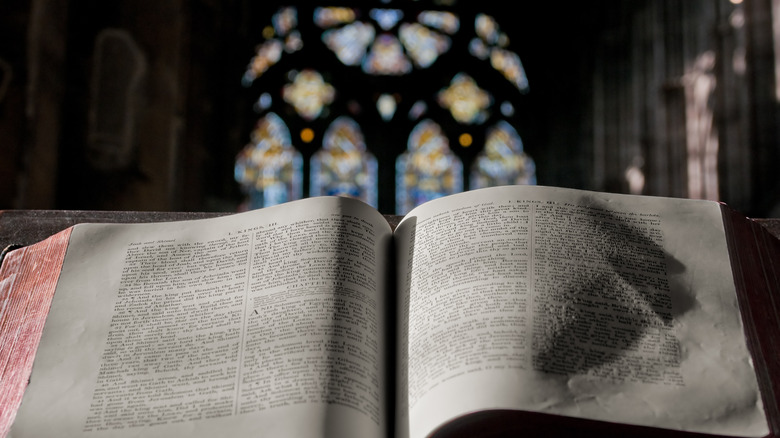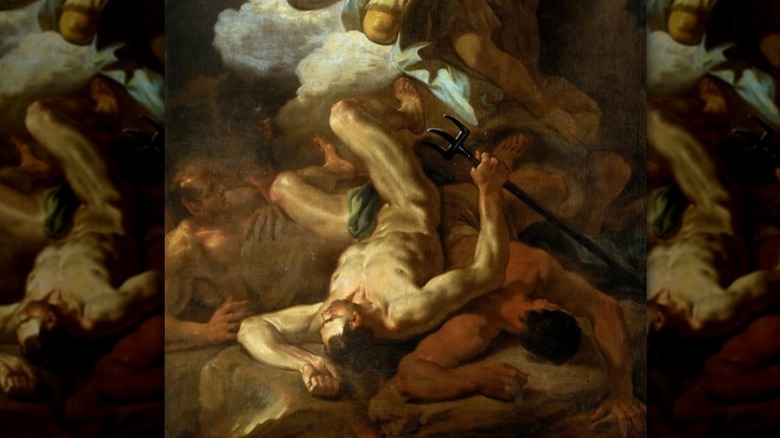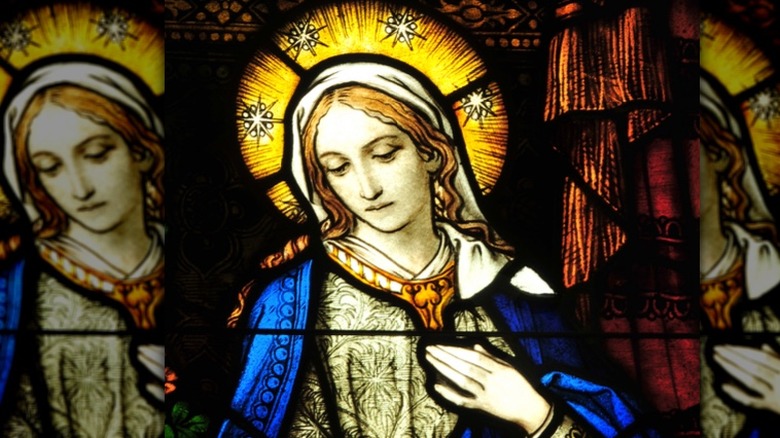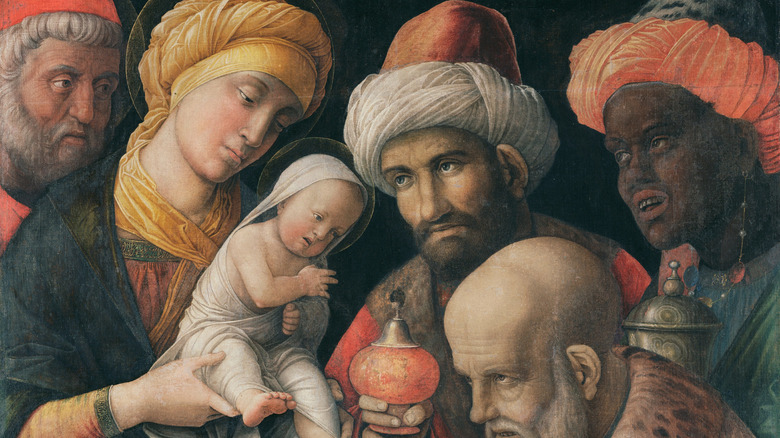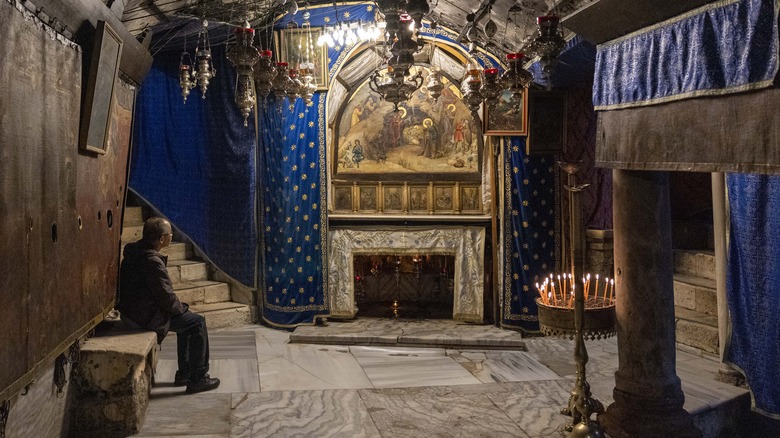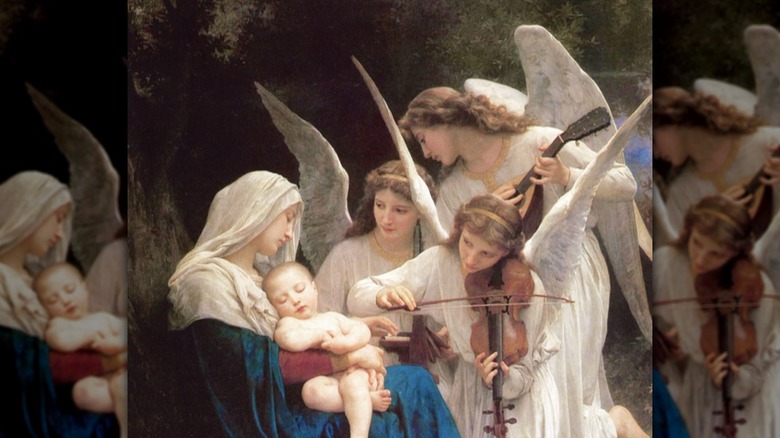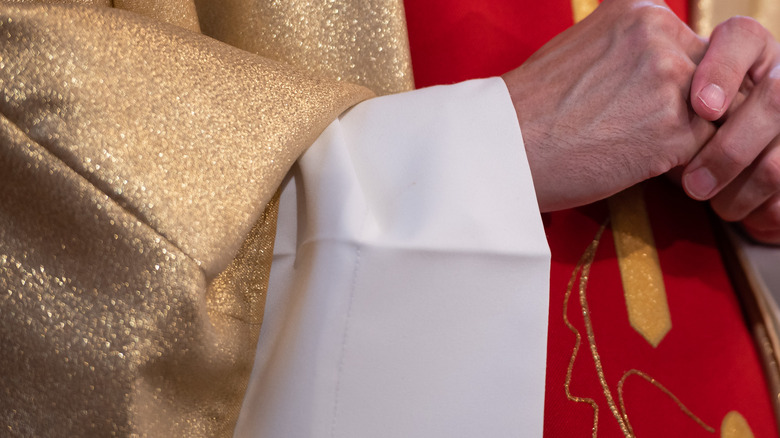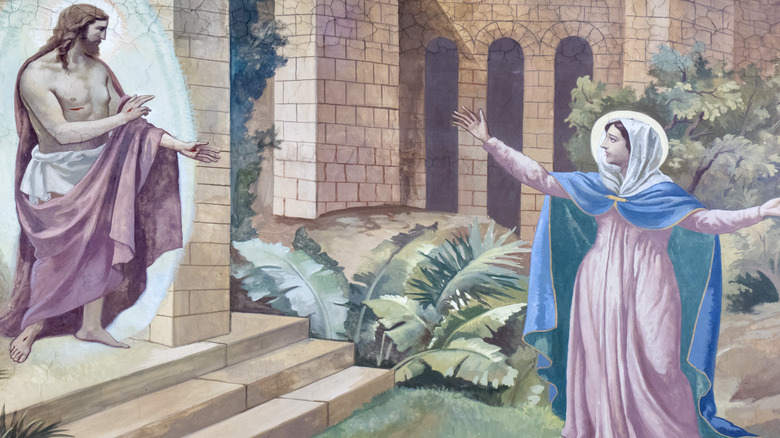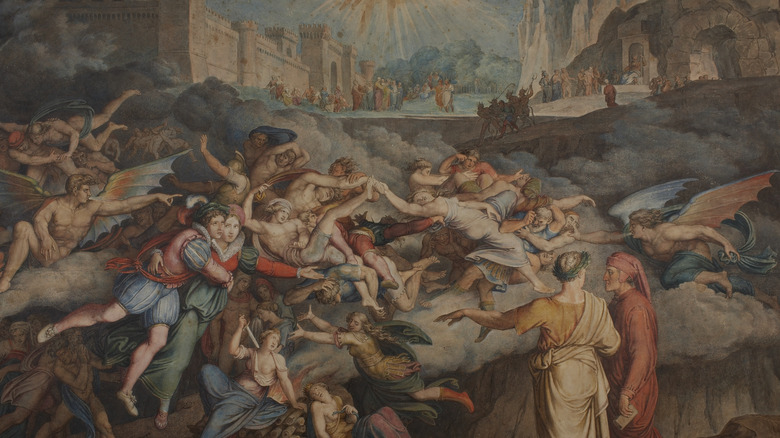Things People Believe Are In The Bible But Aren't
At Christmastime, many people take out their Nativity sets, showing Jesus in a stable surrounded by Mary, Joseph, shepherds, animals, and the three Magi. But what might be wrong with this scene? Broadly speaking, nothing at all. However, at least one of those elements — the idea of three Magi specifically — is not in the Bible. This example illustrates a common theme in Christian debate: how much of Christian tradition and belief is explicitly mentioned in its holy book?
Surprisingly, many of Christianity's more popular conceptions and practices are not in the Bible at all. Mary Magdalene is not depicted as a prostitute, Satan isn't equated to Lucifer, nor is the Catholic dogma of the Immaculate Conception directly referred to. In fact, many teachings are inferred from bringing together multiple verses in conjunction with tradition — even if the Bible does not name them directly.
Here are some examples of things that are commonly held to be in the Bible, but do not don't actually appear in it.
Lucifer as Satan
Satan, the angel who was cast out of heaven after rebelling against God, is popularly referred to as "Lucifer." The name literally means "light bringer" in Latin, referring to the Morning Star (Venus). Strangely enough, despite such widespread use, there is no direct biblical basis for the association.
The passage used to support the equation is Isaiah 14:12. The King James translation, which is at the heart of the confusion due to its explicit use of the name Lucifer, reads, "How art thou fallen from heaven, O Lucifer, son of the morning! how art thou cut down to the ground...!" Since the verse appears to describe a celestial being who fell from the sky, it is reasonable to conclude that Satan and Lucifer are the same, particularly in the context of Luke 10:18, wherein Jesus says, "...I beheld Satan as lightning fall from heaven." Reading further, however, Isaiah 14:16-14:22 clarifies that the passage refers to the mortal king of Babylon.
The association with Lucifer was figurative, comparing the king of Babylon's pride and wickedness to that of the devil. But it was never seen as a one-to-one correspondence. The Protestant reformers generally agreed, noting that the association was based on ignorance, not the biblical text itself. After all, if Lucifer were Satan, Jesus probably would not have referred to himself as the morning star in Revelation 22:16.
The Immaculate Conception
The Immaculate Conception is a Catholic dogma, which, contrary to popular belief, refers not to Jesus' conception, but to the Virgin Mary's. In a nutshell, it holds that the Virgin Mary, although conceived through normal intercourse, was shielded from original sin. Catholics are required to believe in dogmas, so one would expect an explicit reference in the New Testament to back up the Immaculate Conception. But there is no Gospel account describing Mary's conception or its circumstances.
The dogma was instead inferred from multiple bible verses, Church tradition, and logic. The key passage comes from Luke's Gospel, wherein Mary is described as "full of grace" (or "highly favored" depending on the translation). This was historically interpreted as saying that she alone possessed a special grace as the mother of God, that other women did not have.
Early Christian theologians agreed: St. Ephrem the Syrian's "Prayer to the Theotokos," for instance, calls Mary the "All-holy Lady Theotokos ... wholly pure in soul and body." Pope Pius IX, therefore, realized that logically, if Mary was completely pure and free of sin, unlike all other women ever created, she could not have the stain of original sin. Hence, the pope elevated the teaching to dogma in 1854. But because of the lack of a direct biblical reference, Protestants rejected it, and even some Catholics took issue with it.
The apple of the Garden of Eden
The phrase "the forbidden fruit" originates in Genesis 3, a reference to Eve's consumption of the fruit of the Garden of Eden's tree of life, contrary to God's commands. Popular culture has envisioned the fruit as an apple, a trope that notably appears in "Snow White and the Seven Dwarves." But as with numerous popular biblical beliefs, there is no mention of any apple in the Bible.
The English association of the fruit with the "apple" seems to come from John Milton's "Paradise Lost." Milton twice alludes to Eve, writing in the first case, "To satisfy the sharp desire I had Of tasting those fair apples, I resolved Not to defer; hunger and thirst at once." But Milton was likely going off an older Latin translation of the verse – St. Jerome's Vulgate.
Biblical scholar Professor Robert Appelbaum told NPR that the association of the fruit with an apple was likely Bible translator St. Jerome's play on two Latin words. The adjective "malus" (neuter: malum) means "bad" or "evil" in Latin. The noun "malum" means "apple" or simply "fruit." In Northern Europe, German painters rolled with the pun and depicted the fruit as an apple, as did Milton. In Milton's case, however, it is unclear whether he meant to identify Eve's fruit with an apple, or used it as a metaphor. Regardless, his poem crystallized the association between Eve's fruit and apples, which survives in popular Anglophone culture to this day.
The three kings
The Magi (aka the three wise men or three kings), Zoroastrian priests who brought Jesus gifts in celebration of his birth, are a mainstay of Nativity scenes, enjoying a firm biblical foundation in Matthew 2. Their number, however, is in dispute. Traditional scenes usually depict three of them. This number, however, is based on extrapolation and tradition and does not appear anywhere in the Bible, nor is there any mention of them having been kings.
The idea that there were three kings is based on numerical parallels in the Gospel of Matthew. Matthew 2:11 states that the Magi brought the child Jesus gifts of gold, frankincense, and myrrh. If there were three gifts, early Christian theologians concluded there were three magi – one for each gift. But early Christian art from Rome's catacombs is inconclusive. Reverend W.H. Withrow noted in his travel account, "The Catacombs of Rome," that the frescoes depicted anywhere from two to four magi.
Withrow assumed the differing numbers were an artistic choice to preserve symmetry. Middle Eastern Christian traditions, however, suggest that early Christians disagreed on the number of Magi: Assyrian Christian texts and legends from Iraq, Syria, and Turkey claim there were 12. According to Professor Brett Landau, in one legendary Christian text dating back to the eighth century, "Revelation of the Magi," the wise men are given biblical pedigrees stretching back to Genesis.
Jesus being born in a stable
The primary form of the Nativity scene depicts Jesus' birth as taking place in a stable. The Bible, however, does not mention a stable. In fact, it is virtually silent on the structure — artificial or otherwise — Jesus was born in. Luke 2:7 says that he was laid in a manger because there was no room at the inn, while Matthew 2:11 mentions the Magi "entered the house" where the Virgin Mary and the infant Jesus were resting.
Fr. John Flader writes in the Catholic Leader that although the Bible is silent regarding Jesus' exact birthplace, Christians across time assumed it was a stable because of the reference to a manger. One is most likely to find a manger – a feeding trough for farm animals — in a stable or barn. After the birth, the Holy Family could plausibly have moved to the house mentioned in Matthew, where they waited for the Magi.
Early Christian tradition from the Holy Land, however, paints a different story. St. Justin Martyr, an early saint from Nablus writing around 150 AD, said that local Christians and even non-Christians believed that Jesus was born in a small shepherd's cave near Bethlehem. That cave is today marked by the Church of the Nativity – a major pilgrimage site for Christians across denominations. However, as CNEWA notes, it is often a surprise for Christians unfamiliar with St. Justin Martyr to find that Jesus may not have been born in a stable.
The depiction of angels as angelic
Angels are popularly thought of as beautiful, winged, pure, white-clad beings – think the long, golden-haired beings serenading the Virgin Mary and Jesus in William-Adolphe Bouguereau's "La Vierge aux Anges" (pictured above). However, this depiction has little biblical basis, as the few angels explicitly described in the Bible do not look quite so angelic in the English sense of the word.
Christianity recognizes nine ranks of angels. Ezekiel 10-14 gives the clearest description of the second-highest rank – the Cherubim. They are winged beings with four faces: one of a lion, one of a man, one of a cherub, and one of an eagle. Furthermore, their bodies are covered in eyes. This frightening visage hardly gels with the modern-day white-clad, golden-haired angel found in Western art.
Among early Christians, images of angels were not quite as graphic as Ezekiel's, but still far from modern versions. For instance, the oldest surviving depiction of the Annunciation from the Priscilla Catacomb in Rome shows the Archangel Gabriel addressing the Virgin Mary. The archangel appears to be dressed like any Roman male and does not have wings. In the fourth century AD, the modern form of angels appeared, as they were assimilated into the images of deities such as the winged Goddess of Victory.
Clerical celibacy
The Roman Catholic Church's rule of clerical celibacy is a well-known political and theological lightning rod that has stood for nearly a millennium. Given how ardently Catholicism defends this rule, one would expect a clear biblical mandate. The reality, however, is way more complicated.
The Bible praises clerical celibacy, but does not actually require it, therefore early Church practices varied. Sometimes, priests had to renounce their wives. In other cases, they were admitted to the priesthood, but had to abstain from sex, as seen in Canon 33 of the Council of Elvira from A.D. 309. In other cases, they were allowed to continue living with their wives as before. St. Epiphanius was one of the few advocates for celibacy, but he was in the minority. All that said, however, celibate men were considered the ideal candidates for the priesthood, following the example of Jesus Christ himself.
The prohibitions of priestly marriage evolved gradually, and not always out of biblical concerns. For instance, the fifth century A.D. prohibition on bishops marrying was out of fear of nepotism. The definitive Roman Catholic ban came with Canon 21 of the First Lateran Council in 1123. But because the Bible does not explicitly require celibacy, the Roman Catholic Church's ban is a rule – not a dogma – that a pope could theoretically overturn. The 23 other Catholic churches in union with Rome allow married men to become priests and have children, as does Eastern Orthodoxy.
Thou shalt not kill
The fifth Commandment (sixth in Protestant ordering) is generally translated as "thou shalt not kill." The wording of this commandment and its translation has caused no end of debates among Christians, with some even taking the position that all killing is forbidden. The word "kill," however, as understood in English today (i.e., taking someone else's life, regardless of circumstance), does not actually appear in the biblical text.
The commandment's meaning rests on its original Jewish context. The Hebrew word for "kill" has usually been understood to refer to murder – the taking of innocent human life without just cause. Due to the numerous disagreements over this interpretation, Bible translators of non-Semitic languages may have chosen the broader term "to kill" to avoid getting bogged down in cultural and linguistic nuances.
Despite the disagreements and translation issues, the historical Protestant and Catholic positions favor the murder interpretation, because other biblical references appear to allow killing in certain circumstances. For instance, Romans 13:4 explicitly says that it is the job of the just to bring God's wrath down upon the wicked by the sword. The Bible is also full of wars and killings — primarily in the Old Testament — some of which are divinely mandated. All of this would be inconsistent with a blanket ban on killing. In Catholicism, however, this commandment is once again up for debate following Pope Francis' rejection of the death penalty in 2020 — something the Church had historically supported.
Mary Magdalene the prostitute
Mary Magdalene is largely viewed as a repentant prostitute in popular Western Christian thought. The Bible, however, is completely silent regarding her occupation, noting only in Luke 8:2-3 that she was a woman who followed Jesus after he cured her of demonic possession, supporting his ministry from her own pocket.
Mary Magdalene's identification as a prostitute comes primarily from Pope St. Gregory the Great and medieval artists, where the former identified Mary Magdalene with the woman who begged Jesus' forgiveness in Luke 7:36-50. The Bible does specify the woman's sin, but it seems that Church tradition and St. Gregory assumed it was sexual for two reasons. She was considered untouchable, likely due to sexual sin, while a derivative of the name "Magdalene" became a byword for adultery in Jewish tradition. Since Luke ended chapter 7 and suddenly introduced Mary Magdalene in the first three verses of chapter 8, the pope argued they were the same.
Gregory, however, never argued Mary Magdalene was a prostitute. Western European medieval artists were the ones who depicted her as a repentant prostitute, taking Gregory's conclusion further than what he actually said. Art dictates culture, so that is the image that has been preserved in the West. In Eastern Orthodoxy, there is no mention of sexual sin, noting only that she repented of a life of unspecified sin after meeting Christ.
Levels of Hell
The Bible does not say a ton about Hell. The general characteristics of Hell from the Bible note that it exists, there is much misery, wailing, and gnashing of teeth, there is a lake of fire where the damned are tormented, and that once you're in, there is no getting out. But there is nothing about Hell having different physical levels where different types of eternally condemned sinners end up.
The idea of different levels of Hell comes principally from images of Hell found in medieval literature, most notably in Florentine poet Dante Alighieri's "Inferno." In his work, Dante divided hell into nine levels, placing the worst sinners in the lowest, smallest level, while placing progressively lesser sinners in the higher, larger levels.
Although the Bible does not mention physically divided levels of hell a la Dante, there is suggestion that some sinners will receive worse punishment in hell than others, depending on the level of sin. Luke 12:47-48, for instance, says that those who intentionally sin worse will receive a more severe punishment than those who were ignorant.
The Star of David
The Star of David is easily recognizable as the international symbol of Judaism and of the state of Israel, where it occupies the central place on the country's flag. It might be expected that the symbol of the religion that contributed so much to the first part of the Bible would appear in the bible. However, the hexagram symbol is extra-Biblical.
The origins of the Jewish Star of David are legion. Jewish tradition tells that it was the emblem King David carried into battle on his shield. In the Talmud, this imagery is instead used to refer to God himself, who acts as David's shield. It was also the symbol of the Bar Kokhba revolt against Rome. But the symbol is also found in numerous other cultures, including Islam, Christianity, and Dharmic religions such as Buddhism.
Thus, the star's explicit Jewish connection is much more recent and extra-biblical. The symbol appeared in Jewish synagogues as early as the 3rd century AD. But it did not become identified with Judaism until either the 14th century, when the Jews of Prague adopted it as the symbol of their ghetto, or the 17th century, when the Jews of Vienna did likewise. In 1897, the World Zionist Congress adopted the star as a symbol of global Judaism, an association that continues today.
